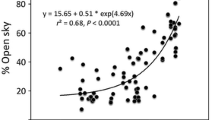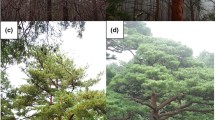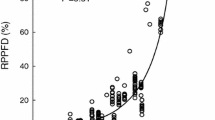Abstract
Structural and physiological changes that occur as trees grow taller are associated with increased hydraulic constraints on leaf gas exchange, yet it is unclear if leaf-level constraints influence whole-tree growth as trees approach their maximum size. We examined variation in leaf physiology, leaf area to sapwood area ratio (L/S), and annual aboveground growth across a range of tree heights in Eucalyptus regnans. Leaf photosynthetic capacity did not differ among upper crown leaves of individuals 61.1–92.4 m tall. Maximum daily and integrated diurnal stomatal conductance (g s) averaged 36 and 34 % higher, respectively, in upper crown leaves of ~60-m-tall, 80-year-old trees than in ~90-m-tall, 300-year-old trees, with larger differences observed on days with a high vapor pressure deficit (VPD). Greater stomatal regulation in taller trees resulted in similar minimum daily leaf water potentials (Ψ L) in shorter and taller trees over a broad range of VPDs. The long-term stomatal limitation on photosynthesis, as inferred from leaf δ 13C composition, was also greater in taller trees. The δ 13C of wood indicated that the bulk of photosynthesis used to fuel wood production in the main trunk and branches occurred in the upper crown. L/S increased with tree height, especially after accounting for size-independent variation in crown structure across 27 trees up to 99.8 m tall. Despite greater stomatal limitation of leaf photosynthesis in taller trees, total L explained 95 % of the variation in annual aboveground biomass growth among 15 trees measured for annual biomass growth increment in 2006. Our results support a theoretical model proposing that, in the face of increasing hydraulic constraints with height, whole-tree growth is maximized by a resource trade-off that increases L to maximize light capture rather than by reducing L/S to sustain g s.







Similar content being viewed by others
References
Ambrose AA, Sillett SC, Dawson TE (2009) Effects of tree height on branch hydraulics, leaf structure and gas exchange in California redwoods. Plant Cell Environ 32:743–757
Ambrose AA, Sillett SC, Koch GW, Van Pelt R, Antoine ME, Dawson TE (2010) Effects of height on treetop transpiration and stomatal conductance in coast redwood (Sequoia sempervirens). Tree Physiol 30:1260–1272
Ashton DH (2000) The environment and plant ecology of the hume range, Central Victoria. Proc R Soc Vic 112:185–278
Ashton DH, Chinner JH (1999) Problems of regeneration of the mature Eucalyptus regnans (the big ash) forest, in the absence of fire at Wallaby Creek, Victoria, Australia. Aust For 62:265–280
Australian Bureau of Meteorology (2007) Trend maps: trend in annual total rainfall for Victoria. Commonwealth of Australia Bureau of Meteorology, Melbourne. http://www.bom.gov.au/cgi-bin/silo/reg/cli_chg/trendmaps.cgi
Becker P, Meinzer FC, Wullschleger SD (2000) Hydraulic limitation of tree height: a critique. Funct Ecol 14:4–11
Buckley TN, Roberts DW (2006a) DESPOT, a process-based tree growth model that allocates carbon to maximize carbon gain. Tree Physiol 26:639–669
Buckley TN, Roberts DW (2006b) How should leaf area, sapwood area, and stomatal conductance vary with tree height to maximize growth? Tree Physiol 26:145–157
Callaway RM, Sala A, Keane RE (2000) Succession may maintain high leaf area: sapwood area ratios and productivity in old subalpine forests. Ecosystems 3:254–268
Connor DJ, Legge NJ, Turner NC (1977) Water relations of mountain ash (Eucalyptus regnans) forests. Aust J Plant Physiol 4:753–762
Das A, Stephenson NL, Flint A, Das T, van Mantgem PJ (2013) Climatic correlates of tree mortality in water- and energy-limited forests. PLoS One 8(7):e69917. doi:10.1371/journal.pone.0069917
Delzon S, Sartore M, Burlett R, Dewar R, Loustau D (2004) Hydraulic responses to height growth in maritime pine tree. Plant Cell Environ 27:1077–1087
England JR, Attiwill PM (2007) Changes in sapwood permeability and anatomy with tree age and height in the broad-leaved evergreen species Eucalyptus regnans. Tree Physiol 27:1113–1124
Ethier GJ, Livingston NJ (2004) On the need to incorporate sensitivity to CO2 transfer conductance into the Farquhar–von Caemmerer–Berry photosynthesis model. Plant Cell Environ 27:137–153
Gerrish G (1990) Relating carbon allocation patterns to tree senescence in Metrosideros forests. Ecology 71:1176–1184
Ishii HR, Azuma W, Kuroda K, Sillett SC (2014) Pushing the limits to tree height: could foliar water storage compensate for hydraulic constraints in Sequoia sempervirens? Funct Ecol 28:1087–1093. doi:10.1111/1365-2435.12284
Keith H, Mackey BG, Lindenmayer DB (2009) Re-evaluation of forest biomass carbon stocks and lessons from the world’s most carbon-dense forests. Proc Natl Acad Sci USA 106:11635–11640
Kilinc M, Beringer J, Hutley LB, Haverd V, Tapper N (2012) An analysis of the surface energy budget above the world’s tallest angiosperm forest. Agric For Meteorol 166–167:23–31
Koch GW, Sillett SC, Jennings GM, Davis SD (2004) The limits to tree height. Nature 428:851–854
Köstner B, Falge E, Tenhunen JD (2002) Age-related effects on leaf area/sapwood area relationships, canopy transpiration and carbon gain of Norway spruce stands (Picea abies) in the Fichtelgebirge, Germany. Tree Physiol 22:567–574
Langford KJ (1976) Change in yield of water following a bushfire in a forest of Eucalyptus regnans. J Hydrol 29:87–114
Latham P, Tappeiner J (2002) Response of old-growth conifers to reduction in stand density in western Oregon forests. Tree Physiol 22:137–146
Legge NJ (1985) Relating water potential gradients in mountain ash (Eucalyptus regnans) to transpiration rate. Aust J Plant Physiol 12:89–96
Lindenmayer DB, Cunningham RB, Donnelly CF, Franklin JF (2000) Structural features of old-growth Australian montane ash forests. For Ecol Manag 134:189–204
Lindenmayer DB, Laurance WF, Franklin JF (2012) Global decline in large old trees. Science 338:1305–1306
Long JN, Smith FW (1988) Leaf area–sapwood area relations of lodgepole pine as influenced by stand density and site index. Can J For Res 18:247–250
Magnani F, Mencuccini M, Grace J (2000) Age-related decline in stand productivity: the role of structural acclimation under hydraulic constraints. Plant Cell Environ 23:251–263
McDowell NG, Barnard HR, Bond BJ, Hinckley TM, Hubbard RM, Ishii H, Köstner B, Meinzer FC, Marshall JD, Magnani F, Phillips N, Ryan MG, Whitehead D (2002a) The relationship between tree height and leaf area:sapwood area ratio. Oecologia 132:12–20
McDowell NG, Phillips N, Lunch C, Bond BJ, Ryan MG (2002b) An investigation of hydraulic limitation and compensation in large, old Douglas-fir trees. Tree Physiol 22:763–774
McDowell NG, Brooks JR, Fitzgerald SA, Bond BJ (2003) Carbon isotope discrimination and growth response of old Pinus ponderosa trees to stand density reductions. Plant Cell Environ 26:631–644
Medhurst JL, Beadle CL (2002) Sapwood hydraulic conductivity and leaf area–sapwood area relationships following thinning of a Eucalyptus nitens plantation. Plant Cell Environ 25:1011–1019
Mokany K, McMurtrie RE, Atwell BJ, Keith H (2003) Interaction between sapwood and foliage area in alpine ash (Eucalyptus delegatensis) trees of different heights. Tree Physiol 23:949–958
Petit G, Pfautsch S, Anfodillo T, Adams MA (2010) The challenge of tree height in Eucalyptus regnans: when xylem tapering overcomes hydraulic resistance. New Phytol 187:1146–1153
Phillips NG, Bond BJ, McDowell NG, Ryan MG (2002) Canopy and hydraulic conductance in young, mature and old Douglas-fir trees. Tree Physiol 22:205–211
Phillips NG, Buckley TN, Tissue DT (2008) Capacity of old trees to respond to environmental change. J Integr Plant Biol 50(11):1355–1364
Ryan MG, Yoder BJ (1997) Hydraulic limits to tree height and growth. Bioscience 47:235–242
Ryan MG, Phillips N, Bond BJ (2006) The hydraulic limitation hypothesis revisited. Plant Cell Environ 29:367–381
Sillett SC, Van Pelt R, Koch GW, Ambrose AR, Carroll AL, Antoine ME, Mifsud BM (2010) Increasing wood production through old age in tall trees. For Ecol Manag 259:976–994
Sillett SC, Van Pelt R, Carroll AL, Kramer RD, Ambrose AR, Trask D (2015) How do tree structure and old age affect growth potential of California redwoods? Ecol Monogr (in press)
Thomas SC (2011) Age-related changes in tree growth and functional biology: the role of reproduction. In: Meinzer FC, Lachenbruch B, Dawson TE (eds) Size- and age-related changes in tree structure and function. Springer, New York, pp 33–64
Tng DYP, Williamson GJ, Jordan GJ, Bowman DMJS (2012) Giant eucalypts—globally unique fire-adapted rain-forest trees? New Phytol 196:1001–1014
Van Mantgem PJ, Stephenson NL, Byrne JC, Daniels LD, Franklin JF, Fule PZ, Harmon ME, Larson AJ, Smith JM, Taylor AH, Veblen TT (2009) Widespread increase of tree mortality rates in the western United States. Science 323:521–524
Van Pelt R, Sillett SC, Nadkarni NM (2004) Quantifying and visualizing canopy structure in tall forests: methods and a case study. In: Lowman MD, Rinker HB (eds) Forest canopies, 2nd edn. Academic, New York, pp 49–72
Van Pelt R, Sillett SC (2008) Crown development throughout the lifespan of coastal Pseudotsuga menziesii, including a conceptual model for tall conifers. Ecol Monogr 78:283–311
Vertessy RA, Benyon RG, O’Sullivan SK, Gribben PR (1995) Relationship between stem diameter, sapwood area, leaf area, and transpiration in a young mountain ash forest. Tree Physiol 15:559–567
Wagenmakers E-J, Farrell S (2004) AIC model selection using Akaike weights. Psychon Bull Rev 11:192–196
West GB, Brown JH, Enquist BJ (1999) A general model for the structure and allometry in woody plants. Nature 400:664–667
Whitehead D, Beadle CL (2004) Physiological regulation of productivity and water use in Eucalyptus: a review. For Ecol Manag 193:113–140
Whitehead D, Edwards WRN, Jarvis PG (1984) Conducting sapwood area, foliage area, and permeability in mature trees of Picea sitchensis and Pinus contorta. Can J For Res 14:940–947
Acknowledgments
This research was supported by grants from the National Science Foundation (IOS-0445277 and IOS-1010769) and the endowment creating the Kenneth L. Fisher Chair in Redwood Forest Ecology at Humboldt State University. Comments by Mike Ryan and two anonymous reviewers improved the manuscript. We thank Tom Greenwood, Giacomo Renzullo, Jim Campbell-Spickler, Joe Harris, and Robert Van Pelt for help with tree climbing and sampling, and Jason Beringer and Darren Hocking of Monash University for providing micrometeorological data from the Wallaby Creek eddy-covariance tower. Russell D. Kramer helped with statistical analysis using R. We are especially grateful to Ion Maher and Tony Fitzgerald of Kinglake National Park, Victoria, for research permission, hospitality, and logistical assistance.
Author information
Authors and Affiliations
Corresponding author
Additional information
Communicated by Nina Buchmann.
Appendices
Appendix A
Linear regression equations of leaf δ13C versus height for 90 m trees
Tree | Slope, ‰ m−1 | Intercept, ‰ | N | R 2 | P-value |
|---|---|---|---|---|---|
1 | 0.0834 | −33.907 | 15 | 0.937 | 0.00001 |
2 | 0.0529 | −32.147 | 13 | 0.939 | 0.00001 |
3 | 0.0710 | −32.249 | 15 | 0.867 | 0.00001 |
4 | 0.0494 | −30.822 | 9 | 0.714 | 0.0001 |
5 | 0.1052 | −34.426 | 12 | 0.888 | 0.00001 |
Appendix B
Linear regression equations of leaf nitrogen versus height for 90 m trees
Tree | Slope, mg g−1 m−1 | Intercept, ‰ | N | R 2 | P-value |
|---|---|---|---|---|---|
1 | 0.0560 | 14.320 | 15 | 0.470 | 0.005 |
2 | 0.0150 | 15.254 | 14 | 0.127 | 0.23 |
3 | 0.0359 | 15.995 | 15 | 0.409 | 0.01 |
4 | 0.0241 | 16.137 | 11 | 0.160 | 0.20 |
5 | 0.0450 | 13.135 | 12 | 0.421 | 0.03 |
Rights and permissions
About this article
Cite this article
Koch, G.W., Sillett, S.C., Antoine, M.E. et al. Growth maximization trumps maintenance of leaf conductance in the tallest angiosperm. Oecologia 177, 321–331 (2015). https://doi.org/10.1007/s00442-014-3181-6
Received:
Accepted:
Published:
Issue Date:
DOI: https://doi.org/10.1007/s00442-014-3181-6




